Making filo (phyllo) pastry has never been my forte. I don't really need to make it that often because I have my precious filo pastry maker working miracles for all my spanakopita, hortopita and kalitsounia needs:
But filo pastry doesn't work for marathopites, those sensually aromatic seamless fennel pies traditionally made in Hania with wild greens and a lot of fennel, my all-time favorite Greek pita. When I made some marathopites recently, I needed to make the pastry for them myself:

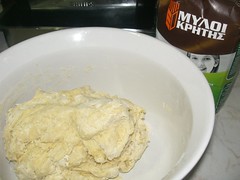
Put some olive oil (no more than 1/3 of a cup) in a bowl, sprinkle a little salt, pour in a shot of tsikoudia, add a cup of water, and slowly mix in a kilo of all-purpose (or strong) flour to get a smooth ball of dough. This pastry can be used for all kinds of pies and pasties: spanakopita, hortopita, kalitsounia, marathopita, mizithropita, among others.
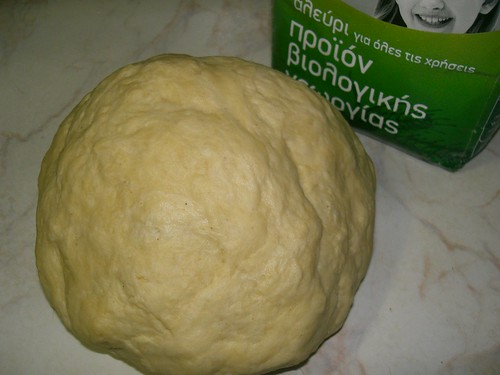
Let your pastry ball rest for about half an hour (at room temperature) before using it.
Meanwhile, I prepared the wild greens mixture. I love this sight:
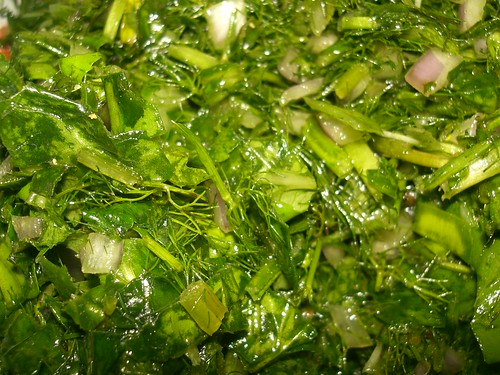 .
.I made a few marathopites, which I piled one by one on top of each other, each layer separated by a cloth. I even managed to roll them out without their popping open and spilling out the filling:
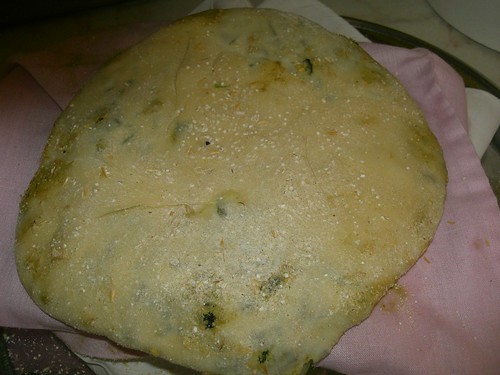
I used white flour to make the dough and wholegrain to spread it for the marathopites. Wholegrain flour suits this kind of pie, which contains wild greens and pungent fennel. This savoury pita is made and cooked in exactly the same way as the mizithropita below.
The wild greens mixture ran out before the pastry. Not wanting to waste it, I decided to make some sweet cheese and honey pies, mizithropites as we call them here, otherwise known as Sfakianes pites (meaning "pies from Sfakia") because they have their origins in this part of Hania. These pites are famous all over the island. They are the best pies in the world. I know I also said that about marathopites; maybe I shoud clarify things a little: the best SAVOURY pies in the world are marathopites, while the best SWEET pies in the world are mizithropites.


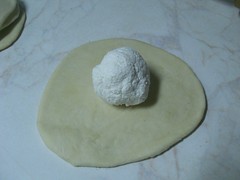

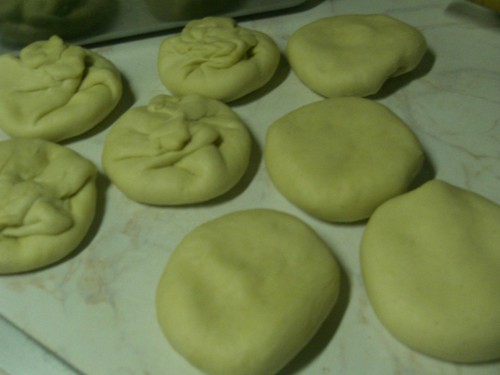
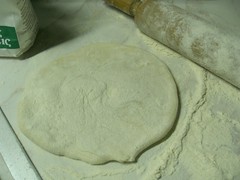
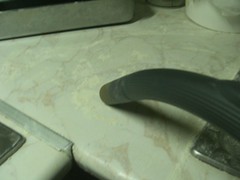

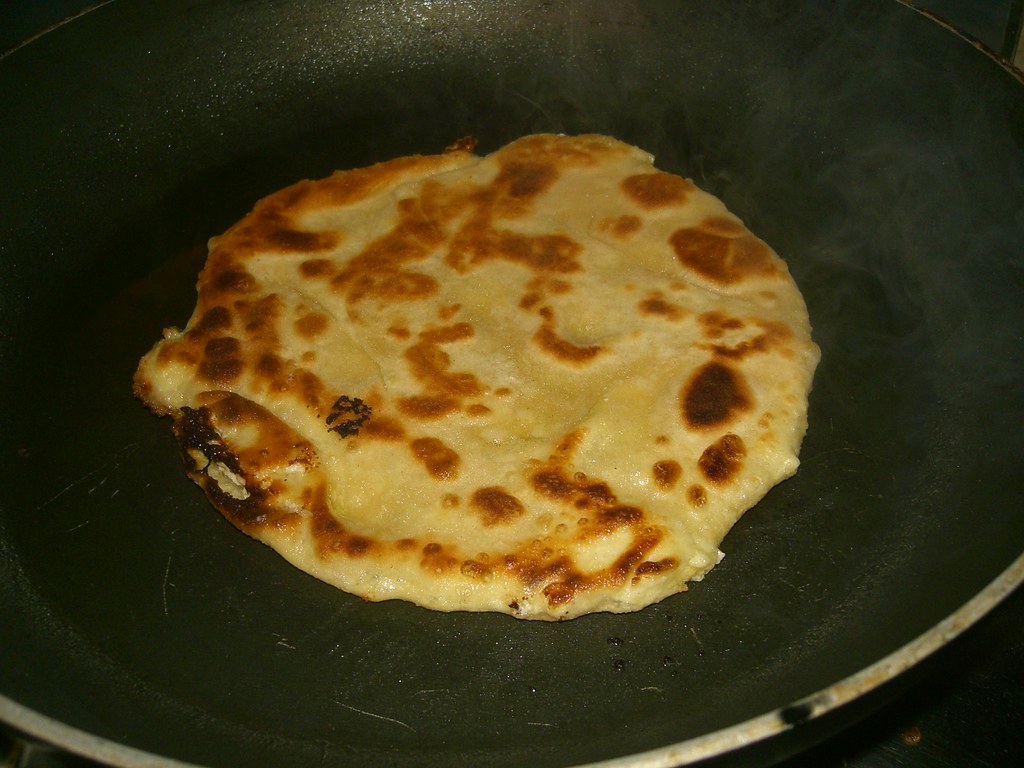
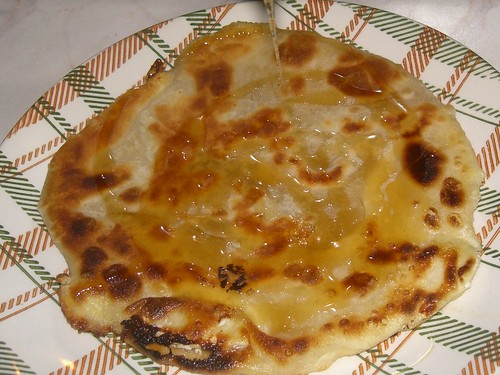
©All Rights Reserved/Organically cooked. No part of this blog may be reproduced and/or copied by any means without prior consent from Maria Verivaki.


The pastry method for making marathopites and mizithropites is exactly the same. Shape small balls of dough the size of a lemon. If you're making marathopites, you'll be using a ladle full of greens mixture; if you're making mizithropites, shape the mizithra (similar to ricotta cheese) into balls the same size as the pastry. The cheese must not be too damp or runny. Mix in some semolina or flour to make it firmer. Don't add any more salt than what it originally contains.


Roll out the dough into a small round. Place the filling (mizithra for sfakianes pites, greens for marathopites) into the centre of the pastry round, wrap it up pouch-like and punch the top of the 'pouch' down. You will end up with fat little rounds of dough that will now be spread out and turned into flat pies, filled with cheese or greens, with a seamless look to them. Everyone will be intrigued as to how the mixtures ended up in the pie, a bit like the ship in the bottle...

Start spreading out the filled pastry. Use flour to keep the pastry from sticking to your work surface and roll them out VERY LIGHTLY (I can't stress this) with a rolling pin or spread them with your hands. I prefer the rolling pin - can you see where my pastry burst open at the rim?


Now you know why I don't like making my own pastry - my whole kitchen ends up resembling Alaska. Try clearing up the flour with a cloth; whatever you touch with it will also get coated in flour if it wasn't in the first place. Maybe a damp cloth is better; that will end up looking like sludge. The vacuum cleaner is the most efficient tool here...


Marathopites and mizithropites can be frozen, one on top of each other, with plastic wrap (I use clean supermarket bags) between each layer. My marathopites went into the deep freeze, but we couldn't resist the mizithropites. They last up to a week in the fridge; you can have them for supper any night of the week. I made a batch of eight (before I ran out of mizithra). Heat up your largest frying pan or a skillet (they were originally cooked on something called a 'satsi' in Greece). Cook them on a hot LIGHTLY OILED pan (too much oil will fry rather than cook them) on both sides till done. When they're ready, pour a HUGE spoonful of honey over them, cut them into quarters and serve.

These pites are also made and cooked using the same technique in other parts of the southeast Mediterranean: have a look at Nihal's spinach borek and potato borek. Borek is a kind of Turkish pie. The word 'borek' is also used in Greece, but as Nihal notes for Turkish cuisine, Greek cuisine is not homogeneous: 'boureki' in Crete is quite different to 'boureki' in Northern Greece, although they both refer to some kind of 'pie'.
*** *** ***
I STILL have some dough left (and no mizithra or greens to fill them with). I must find a way to use it up; I'll just have to make some xerotigana...
©All Rights Reserved/Organically cooked. No part of this blog may be reproduced and/or copied by any means without prior consent from Maria Verivaki.
Yum, Sfakianes pites - one of the many great treats when we go on holiday to Frangokastello (three times so far!). Thanks for bringing back great gastronomic memories!
ReplyDeleteOh, I am drooling....I LOVE sfakiana pites, or should I say Mizithropites (I am learning). Not being able to obtain mizithra cheese i am unable to make them at home. maybe that is a good thing as I would make waay too many and then overeat.
ReplyDeleteAbsolutely delicious Maria! My mother makes similar ones from her village on a flat hot plate...I love the different fillngs but the wild greens is my favourite!
ReplyDeleteAll I need now is to find some mizithra here in London!
ReplyDeleteMaria, I LOVE all types of pites, and I adore fennel! Thank you for your comments on my recent (and less recent) blog posts. You are right, I'm terribly busy at the moment--it's good for the wallet, less so for the writing and keeping connected with friends online and in person--but I am thinking of you, too! I have an idea for another Melting Pot post coming soon (about breakfast foods), but it will have to wait until I have a little more time. For now, just know I'm still here... still enjoying your posts and hoping all's well in Chania!
ReplyDeleteThese pites are so amazing! The wild greens mix are a delicious sight indeed.
ReplyDeleteI love the mizithropites--both look delicious but I have a slight sweet tooth.
ReplyDeleteOh, and I wanted to share this with you ... I was watching the news this morning when I saw a new commercial airing on ... can you believe this ... Disney Eggs! Regular old eggs, packaged and distributed by Disney with little Disney characters imprinted on one side of the egg and a colorful Disney container holding the dozen. I did a quick Internet search but only came up with this: http://www.mikesblender.com/indexblog139.htm
So apparently they were first marketed in Japan last year and now made their way to the U.S. Do children really need a Disney character's face on the shell to eat an egg?! Not my kids ... I'll stick with my organic brown eggs thank you very much.
These look delightful and being a Makedona, new to my eye (love it).
ReplyDelete...and they say Greeks don't like to mix sweet & savory..phooey to that!
How nice! These pies must taste great. And I totally understand why you don't like to make pastry so much. Flour everywhere! But isn't it so worth it at the end, when you're holding a slice of such wonderful pie in your hand? ;)
ReplyDeleteYou're right, these are exactly made like the potato and spinach borek I posted. I love fennel, so I got to try these fennel pies sometime. I'll let you know the result.
ReplyDeleteThanks for linking to my post.
I'm a pitaholic and I want these right NOW! And by these, I mean some of both, please.
ReplyDeleteI'm going to have to figure out what some of that is and probably come up with alternatives but they sound so good I will have to try :)
ReplyDelete